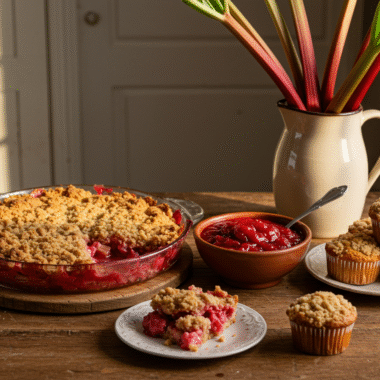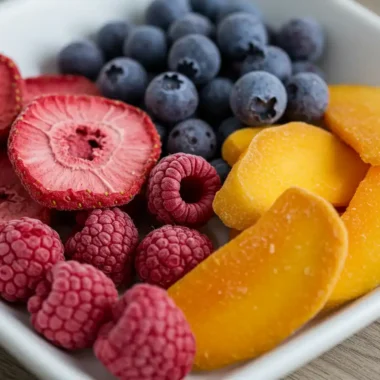Inflammation might start small, but if left unchecked, it can show up as constant fatigue, aching joints, poor digestion, and even stubborn belly weight. If any of that sounds familiar, it’s time to rethink what’s in your blender. With over 15 years of hands-on kitchen experience, I’ve seen just how effective anti inflammatory smoothie recipes can be—not only for taste, but also for real, noticeable health improvements.
In this guide, I’ll walk you through the exact ingredients that work, why they matter, and which smoothie blends my clients ask for again and again. Whether you’re dealing with chronic inflammation or just trying to support your gut and joints, this article will give you the tools to make every sip count.
Want to explore the article content? Click here to see the table of contents!
Table of Contents
What Are Anti Inflammatory Smoothie Recipes?
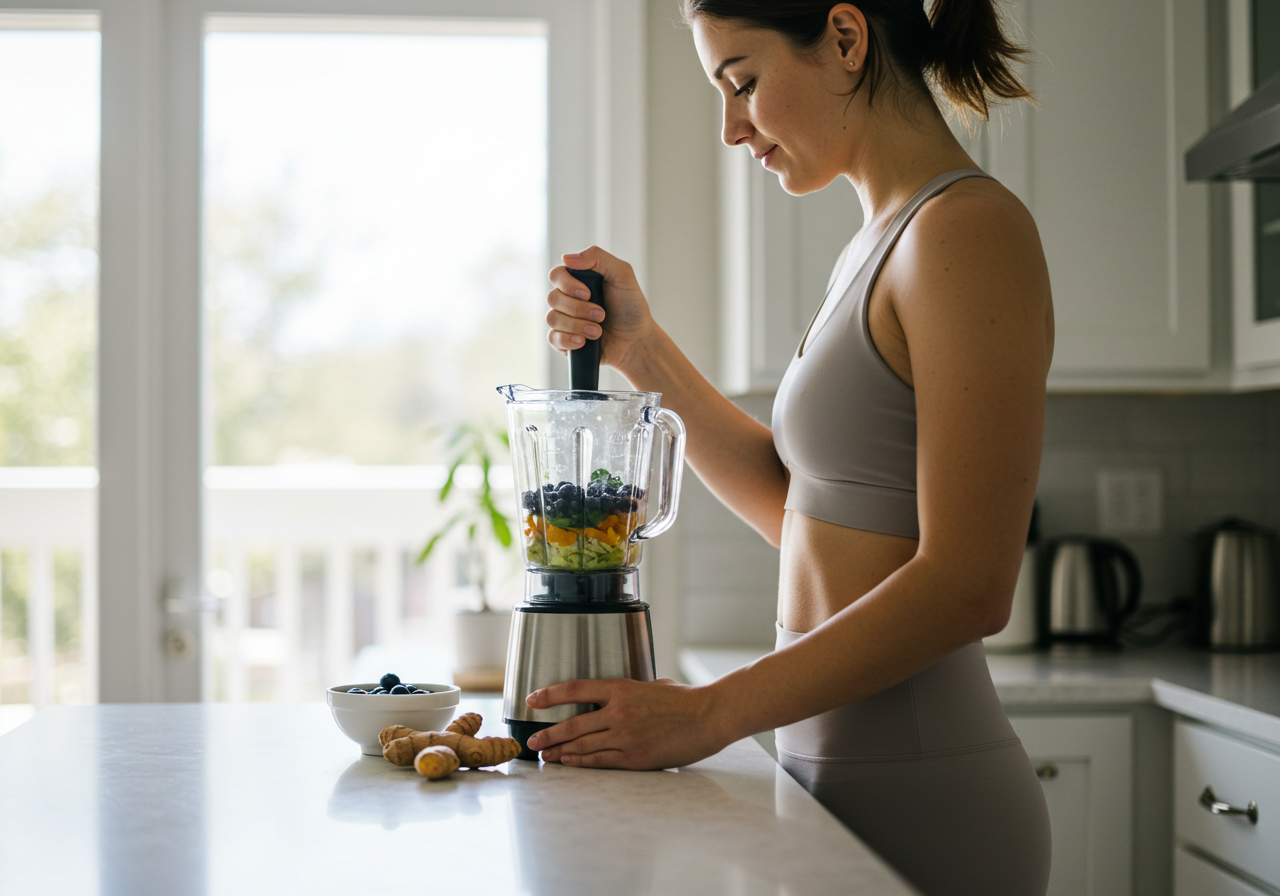
Berry Ginger Glow Smoothie
Ingredients
Equipment
Method
- Add all ingredients to a high-speed blender.1 cup frozen wild blueberries, 1 small banana, 1/2 cup baby spinach, 1 tsp grated fresh ginger, 1/2 tsp turmeric, 1 pinch black pepper, 1 tbsp chia seeds, 3/4 cup unsweetened almond milk
- Blend until smooth and creamy.
- Serve immediately for best flavor and nutritional value.
Nutrition
Video
Notes
- You can prep this smoothie in freezer bags and just add almond milk when ready.
- Swap banana for ¼ avocado to lower sugar.
How anti inflammatory smoothies support your body
Not all smoothies are created with purpose—but these are. Anti inflammatory smoothie recipes are designed to cool the internal “fire” caused by stress, poor diet, toxins, or even long-term injuries. When inflammation sticks around, it disrupts everything from digestion to joint health. That’s where healing blends come in.
Each smoothie packs in ingredients that target inflammation naturally. Think deep-colored berries loaded with antioxidants, greens rich in phytonutrients, and roots like turmeric and ginger that have been used in traditional medicine for centuries. These foods work together to lower inflammation markers in the body—like C-reactive protein—and support your immune system without overcomplicating your diet.
One of the best things about anti inflammatory smoothies is how easy they are to customize. Need a gut boost? Add chia seeds and kefir. Need joint support? Focus on pineapple and turmeric. You’re not just drinking fruit—you’re using food as daily support for healing.
For more detail on how these ingredients influence inflammation, the National Library of Medicine provides research-backed insight into dietary polyphenols and inflammatory response.
Common symptoms that smoothies help reduce
I’ve worked with many people who didn’t even realize they were living with inflammation until we changed what they ate. Once anti inflammatory smoothies became part of their day, these were the changes they noticed first:
- Less morning stiffness in the knees and hands
- Fewer digestive issues like bloating, gas, or cramping
- Clearer, more even-toned skin
- Improved focus and reduced “brain fog”
- More steady energy—no 3 PM crash
It’s not magic. It’s consistency. A few strategic ingredients in your daily smoothie can make a bigger impact than most over-the-counter options. And unlike packaged shakes, these recipes are made with fresh, whole food—no weird additives, no guesswork.
For those managing autoimmune issues or chronic joint pain, blending foods rich in antioxidants, fiber, and anti inflammatory oils is a practical starting point. It’s something you can do daily, and it doesn’t require cutting out everything you love.
If you want to support your body in a way that feels nourishing instead of restrictive, smoothies are a great first step. You can also find more wellness-supportive recipes in my collection of healing gut smoothie ideas crafted specifically for inflammation and digestive balance.
Top Anti Inflammatory Ingredients to Add in Smoothies
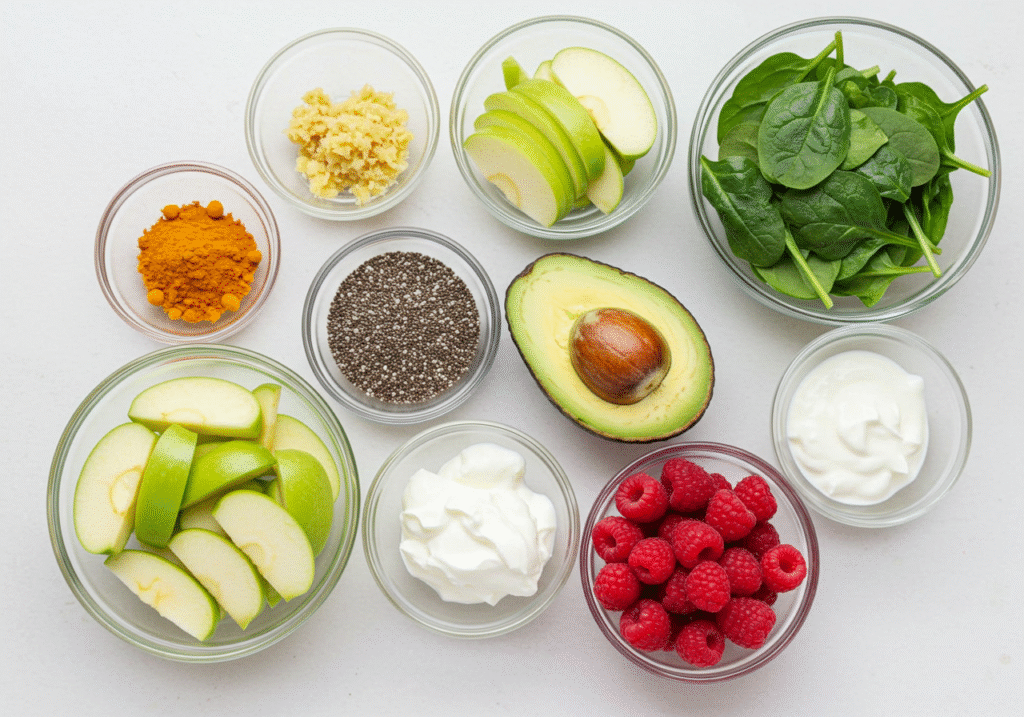
Best fruits and vegetables for inflammation
When it comes to building anti inflammatory smoothie recipes, the ingredients you choose make all the difference. You can’t throw random fruit in a blender and expect healing. After years of recipe development for clients managing chronic inflammation, I can tell you—some ingredients are far more effective than others.
Start with deeply colored fruits. Blueberries, blackberries, and cherries are loaded with anthocyanins. These natural compounds have been shown to reduce oxidative stress and lower inflammation levels. Wild blueberries, in particular, are twice as rich in antioxidants compared to conventional ones. I always recommend keeping a frozen stash on hand.
For vegetables, don’t overlook leafy greens. Spinach blends easily into any smoothie and is full of vitamin K and polyphenols. Kale is slightly stronger in taste but offers more anti inflammatory nutrients per cup. Add half a frozen zucchini for creaminess without altering flavor—this is one of my favorite chef tricks for clients who hate bananas.
Here’s a quick reference for powerhouse produce to use daily:
| Ingredient | Key Benefit |
|---|---|
| Wild Blueberries | Reduces oxidative damage and brain inflammation |
| Cherries | Eases joint pain and post-exercise soreness |
| Spinach | Rich in polyphenols and gut-supportive fiber |
| Zucchini (frozen) | Adds creaminess, vitamin C, and gut-soothing fiber |
A smoothie that combines at least one fruit and one vegetable from this list offers a strong base for inflammation support. Keep your mix colorful and don’t be afraid to rotate ingredients based on what’s in season.
Powerful spices and herbs for anti inflammatory effects
While fruit and vegetables provide bulk and fiber, spices bring in concentrated anti inflammatory strength. They don’t just add flavor—they help calm your system from the inside out. My personal go-to is turmeric. Curcumin, its active compound, has been studied for its ability to reduce inflammation in joints and the digestive system. I always pair turmeric with a pinch of black pepper to improve absorption—something I’ve taught every client who uses it regularly.
Ginger is another powerhouse. Just a teaspoon of freshly grated ginger root can ease bloating and support circulation. It works especially well in morning smoothies because of its warming effect and digestive benefits.
Don’t overlook cinnamon—particularly Ceylon cinnamon. It has properties that may help balance blood sugar and ease inflammation caused by sugar overload or metabolic stress.
To round things out, I always include seeds. Chia seeds and flaxseeds offer omega-3s, fiber, and lignans—compounds that reduce inflammation and support hormone balance. Just one tablespoon can go a long way.
If you’re building your spice shelf, here’s what I recommend:
- Turmeric powder (½ tsp per smoothie, with a dash of black pepper)
- Fresh ginger root (1 tsp grated or ¼ tsp powder)
- Ceylon cinnamon (¼–½ tsp)
- Chia or flaxseeds (1 tbsp per smoothie, ground for better absorption)
These ingredients not only boost your smoothie’s healing potential but also add texture and depth of flavor. For more insight into how turmeric and ginger impact inflammation, you can read current data from the National Institutes of Health, which offers a breakdown of clinical studies.
By building your smoothies with intention—one healing ingredient at a time—you set yourself up for better digestion, more energy, and fewer flare-ups. And trust me, once you start feeling the difference, there’s no going back.
Easy Morning Anti Inflammatory Smoothie Recipes
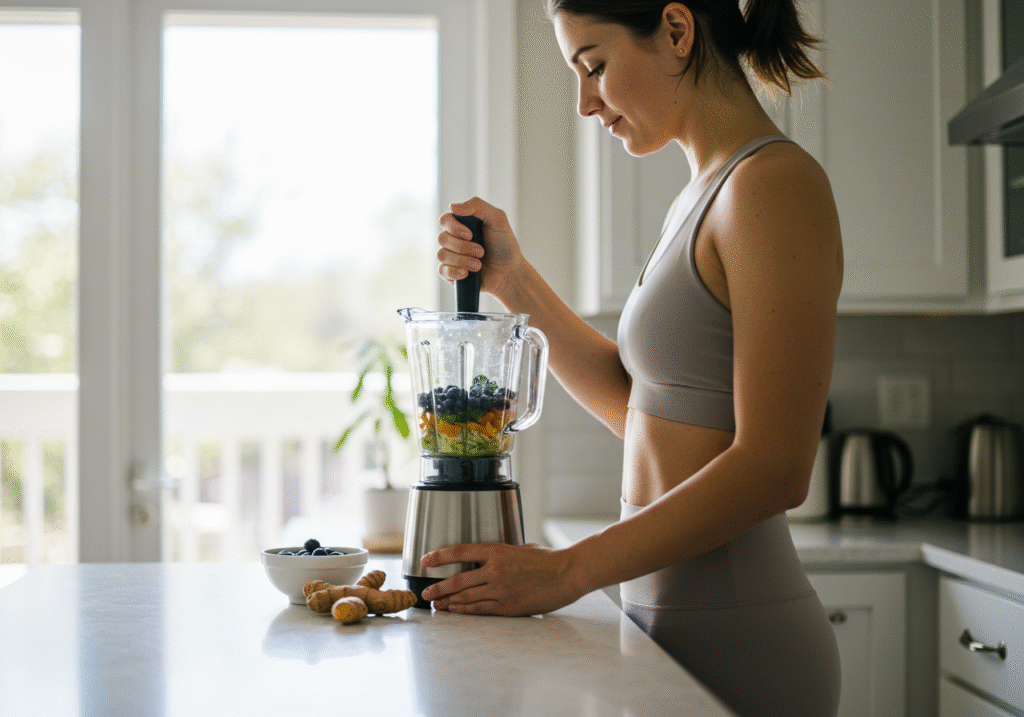
Quick 5-minute breakfast smoothies
You don’t need a gourmet kitchen or a pantry full of powders to start your morning with healing. Some of the most effective anti inflammatory smoothie recipes can be made in under five minutes, with real food you probably already have.
Here are two of my go-to recipes that I recommend for clients needing fast but powerful morning options:
1. Berry Ginger Glow Smoothie
This blend is gentle on the stomach and packed with antioxidants.
Ingredients:
- 1 cup frozen wild blueberries
- 1 small banana
- ½ cup baby spinach
- 1 tsp grated fresh ginger
- ½ tsp turmeric + pinch of black pepper
- 1 tbsp chia seeds
- ¾ cup unsweetened almond milk
Directions:
Blend everything together until smooth. Drink immediately. This recipe supports brain clarity, joint health, and digestion.
2. Green Apple Spice Smoothie
This one’s crisp and energizing—ideal for those who want a low-sugar start.
Ingredients:
- 1 green apple, cored and sliced
- ½ cup cucumber
- 1 stalk celery
- ½ tsp Ceylon cinnamon
- 1 tbsp ground flaxseed
- Juice of ½ lemon
- ¾ cup cold water or coconut water
This smoothie wakes up your gut without spiking blood sugar. I like using it on mornings after a heavier dinner or when inflammation flares up.
These fast recipes are designed to blend in under five minutes with no prep beyond washing or chopping. You can even pre-portion your ingredients into freezer bags the night before—a trick I’ve used in countless meal prep programs with busy families and professionals.
Energy-boosting smoothies for gut support
Morning energy doesn’t just come from caffeine—it starts in your gut. A happy gut supports immune health, mood balance, and less systemic inflammation. That’s why I often build breakfast smoothies with prebiotics, fiber, and anti inflammatory fats.
A favorite blend among my clients includes oats, kefir, berries, and flax. It’s filling and soothing, especially after poor sleep or stress.
Gut Power Smoothie
Ingredients:
- ½ cup kefir (unsweetened, plain)
- ½ banana
- ¼ cup rolled oats
- ½ cup frozen raspberries
- 1 tbsp ground flaxseed
- 1 tsp raw honey (optional)
- ½ cup water
The kefir adds probiotics, while oats and flax deliver prebiotic fiber—feeding the good bacteria that reduce inflammation. Raspberries give this smoothie a tart balance and are rich in polyphenols that support gut lining health.
If mornings are hard on your digestion, start slow—half a serving, sipped over 15 minutes, can ease your system into healing mode.
Post-Workout Anti Inflammatory Smoothie Recipes
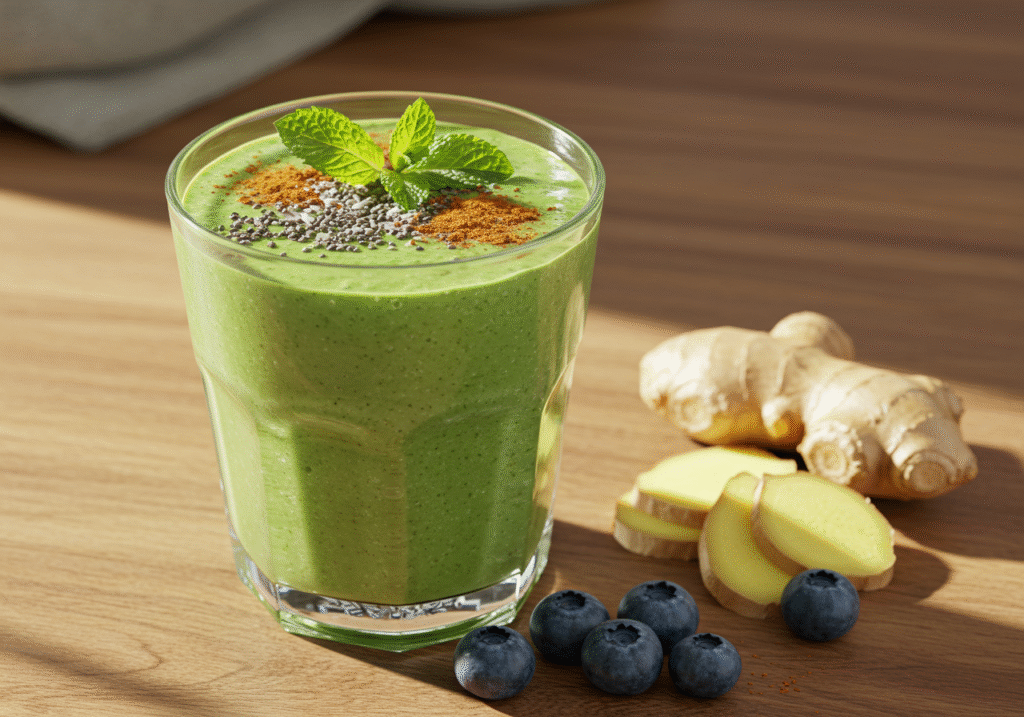
Muscle recovery with smoothies
After a tough workout, your muscles experience microscopic damage—that’s part of how they grow. But if inflammation lingers too long, it slows recovery and can lead to stiffness or even injury. The good news? Smoothies can help your body bounce back faster when you choose the right ingredients.
I always recommend blending within 30 minutes of exercise. This helps replenish nutrients, reduce inflammation, and support muscle repair. Focus on ingredients that deliver a solid dose of protein, potassium, antioxidants, and healthy fats.
My top smoothie for recovery is this anti inflammatory blend that combines tart cherry with plant protein and omega-3s:
Recovery Cherry Protein Smoothie
Ingredients:
- 1 cup frozen tart cherries
- ½ banana
- 1 scoop plant-based protein powder (unsweetened, clean label)
- ½ cup almond milk
- 1 tbsp chia seeds
- ¼ tsp cinnamon
- ½ tsp turmeric + black pepper
- ½ cup water or coconut water
Cherries have been studied for their impact on muscle soreness. A 2010 study published in the Journal of the International Society of Sports Nutrition found that tart cherry juice reduced post-run pain and inflammation markers.
Smoothies like this work best when paired with balanced meals later in the day. If you’re doing strength training or endurance workouts more than 3 times a week, this post-workout smoothie can be a game-changer.
For athletes or anyone building muscle, I recommend rotating between tart cherry, wild blueberry, and pineapple in your recovery smoothies to support different anti inflammatory pathways.
Anti inflammatory protein-rich blends
Protein plays a key role in recovery, but not all sources are created equal. I avoid whey in most of my recipes because it can cause digestive upset and trigger inflammation in sensitive individuals. Instead, I recommend plant-based protein blends made from pea, hemp, or pumpkin seed—clean and gentle on the gut.
This is one of my most requested recipes from clients who work out early and need fuel that won’t leave them heavy or bloated:
Golden Green Post-Workout Smoothie
Ingredients:
- 1 scoop hemp protein
- ½ avocado
- ½ cup frozen mango
- 1 handful baby spinach
- 1 tsp fresh ginger
- ½ tsp turmeric
- Juice of ½ lemon
- 1 cup water
This smoothie is rich in anti inflammatory fats from avocado, chlorophyll from spinach, and magnesium from hemp—great for muscle relaxation and joint recovery.
Clients often report feeling less sore the next day and better overall energy when smoothies like these are used consistently after exercise. They’re light enough to digest quickly but powerful enough to support tissue healing at the cellular level.
Gut-Friendly Anti Inflammatory Smoothie Recipes
Smoothies that soothe the digestive tract
A healthy gut is the foundation of an inflammation-free body. When your gut lining is irritated or your microbiome is off balance, inflammation spreads quickly through your system. That’s why I often build anti inflammatory smoothie recipes specifically to calm and repair the digestive tract.
Certain foods have a naturally soothing effect. Bananas, especially when slightly green, contain resistant starch that feeds healthy gut bacteria. Papaya brings in the enzyme papain, which supports smoother digestion. And aloe vera juice? It’s a little-known favorite in my kitchen for calming the gut lining.
This is one of my most recommended blends for clients dealing with IBS, bloating, or frequent gut discomfort:
Soothing Gut Repair Smoothie
Ingredients:
- ½ banana (slightly green)
- ½ cup papaya (fresh or frozen)
- 1 tbsp ground flaxseed
- 2 tbsp aloe vera juice (food-grade only)
- ¼ tsp fresh grated ginger
- ¾ cup unsweetened almond milk
- 1 scoop collagen peptides (optional)
This combination offers fiber, enzymes, and anti inflammatory agents in one easy blend. It’s ideal for mid-morning or evening, especially if digestion tends to slow down later in the day.
If you’re interested in ingredients that go beyond fruit, check out this list of gut-supportive foods and drinks recommended by registered dietitians and backed by research.
Probiotic and fiber-rich smoothie options
In addition to calming ingredients, probiotics are crucial when crafting smoothies that support gut health and reduce inflammation. These beneficial bacteria help regulate immune response, reduce bloating, and produce short-chain fatty acids that directly lower inflammation in the colon.
For probiotic sources, I prefer kefir, yogurt (unsweetened and dairy-free when needed), or kombucha in small amounts. For fiber, look to oats, flaxseed, and chia seeds. Together, these components improve gut health over time and make your smoothies more satisfying.
Try this nourishing blend when your digestion needs support:
Fiber + Flora Smoothie
Ingredients:
- ½ cup kefir (unsweetened)
- ¼ avocado
- 1 tbsp chia seeds
- ¼ cup rolled oats (soaked if needed)
- ½ cup frozen strawberries
- 1 tsp Ceylon cinnamon
- 1 cup water
This smoothie feeds the gut while keeping blood sugar balanced—a combination that’s especially helpful for those dealing with inflammation from stress or diet triggers. I’ve had clients who added this blend three times a week and noticed real changes in bloating and regularity.
For more smoothie recipes tailored to digestion, check out the dedicated healthy gut smoothie section where I share fiber-balanced blends, tips for probiotic use, and ingredient swaps for sensitive stomachs.
Low Sugar Anti Inflammatory Smoothies
Natural sweeteners and low-glycemic fruits
When it comes to inflammation, sugar is one of the biggest triggers. Even natural sugars from fruit can spike blood glucose levels if the balance is off. That’s why I create anti inflammatory smoothie recipes that use low-glycemic fruits and smarter sweeteners. The goal is flavor without the flare-up.
My go-to fruits for low sugar smoothies include:
- Green apples – crisp and refreshing with less sugar than red apples
- Avocado – adds texture and healthy fat, not sweetness
- Berries (especially blackberries and raspberries) – lower in sugar, high in antioxidants
- Kiwi – tangy and rich in vitamin C, with a lower glycemic load
When a little sweetness is needed, I stick to raw stevia, a splash of unsweetened coconut water, or half a date—never more. You still get a hint of flavor without putting your body into sugar overload.
Here’s a client-favorite recipe that balances sweetness with real inflammation-fighting nutrients:
Green Balance Smoothie
Ingredients:
- ½ green apple
- ¼ avocado
- 1 cup spinach
- Juice of ½ lemon
- 1 tsp grated ginger
- ¼ tsp cinnamon
- 1 tbsp ground flaxseed
- ¾ cup cold green tea or water
This smoothie is light, refreshing, and designed to keep insulin stable—perfect for mornings or an afternoon pick-me-up.
Want to learn more about low glycemic foods and inflammation? This glycemic index guide provides great clarity for making smarter fruit choices.
Diabetic-friendly anti inflammatory smoothie ideas
For those managing type 2 diabetes or insulin resistance, the right smoothie can support blood sugar balance and inflammation control at the same time. It’s all about building structure: protein + fiber + fat + low sugar fruit.
One of the best examples is my Blood Sugar Support Smoothie, developed for a client with metabolic syndrome who needed steady energy without glucose spikes.
Ingredients:
- ½ cup unsweetened almond milk
- ½ zucchini (frozen)
- ½ cup frozen blackberries
- 1 tbsp hemp seeds
- 1 scoop unflavored collagen or plant protein
- ¼ tsp turmeric
- ¼ tsp cinnamon
- Ice as needed
This smoothie contains anti inflammatory spices, fiber from seeds and veggies, and zero added sugars. It’s light but keeps you full for hours.
For those following a diabetic-friendly meal plan, smoothies like these are safer than juice or fruit bowls. They’re structured to reduce post-meal glucose rises and calm internal inflammation, especially in the vascular system.
Tips to Make Your Smoothies More Effective
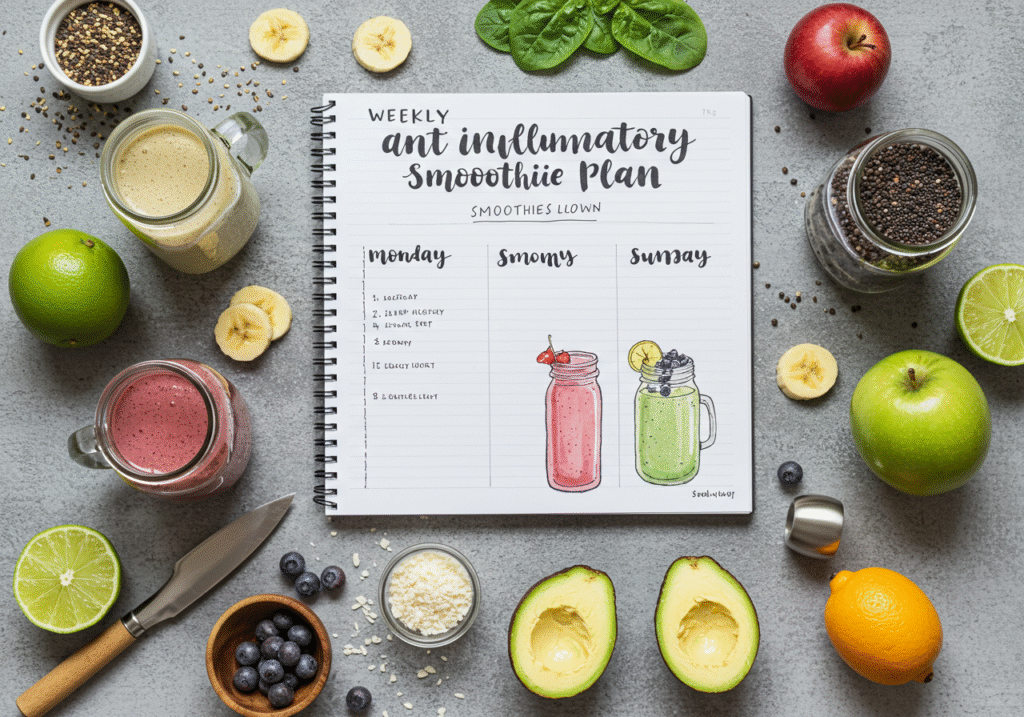
What to avoid in anti inflammatory smoothies
Smoothies are one of the easiest ways to improve your diet—but they can also do more harm than good if you’re not careful. I’ve seen many clients start with great intentions but unknowingly sabotage their goals by using the wrong ingredients.
Here are the most common mistakes I see—and how to fix them:
- Too much fruit: Even natural sugars can trigger inflammation if the balance is off. Limit to one cup per smoothie and always pair with fiber, fat, or protein.
- Fruit juice as a base: Store-bought juices spike blood sugar quickly. Use filtered water, unsweetened almond milk, or brewed green tea instead.
- Flavored yogurts: These often contain added sugars and gums. Always use plain, unsweetened yogurt or kefir if you want probiotics.
- Protein powders with additives: Watch for artificial sweeteners, gums, and dairy-based powders. Look for clean, plant-based or collagen options instead.
Even “healthy” ingredients can become inflammatory depending on how your body responds. That’s why I recommend journaling symptoms and rotating your ingredients every few days. It’s the same approach I use when building client meal plans—consistent testing and mindful adjustments.
Want more insights on common smoothie pitfalls? This breakdown of hidden sugars in health foods from Harvard is worth reading.
How to prep and store smoothies properly
Smoothies are at their best when made fresh—but I understand mornings can get hectic. With a few simple prep steps, you can still get the full anti inflammatory benefits without spending more than a few minutes.
Here’s how I guide my clients through smoothie prep:
- Pre-portion your ingredients: Use freezer-safe bags or glass jars to store pre-chopped fruits, greens, and spices. Just add liquid and blend.
- Store in airtight containers: If you prep a smoothie in advance, store it in a glass jar with no air gap to slow oxidation. Keep refrigerated for up to 24 hours.
- Don’t blend seeds too early: Chia or flax thicken over time. Add them right before blending or they’ll turn gelatinous.
- Use frozen ingredients: Frozen berries, bananas, and even spinach keep smoothies cold without needing ice, while preserving nutrients.
When I batch-prep smoothies for retreats or client programs, I focus on layering ingredients in jars for grab-and-blend convenience. Clients say it removes the morning decision fatigue and makes healthy choices automatic.
These strategies don’t just save time—they help keep your nutrient intake consistent. And that consistency is key when you’re trying to calm long-term inflammation.
Weekly Anti Inflammatory Smoothie Meal Plan
7-day anti inflammatory smoothie recipe guide
One of the most common questions I get from clients is: “Which smoothies should I drink each day?” Having a plan takes the guesswork out of it. That’s why I put together this simple 7-day anti inflammatory smoothie meal plan—tried, tested, and balanced for real results.
This rotation includes a mix of anti inflammatory fruits, fiber-rich greens, gut-supportive herbs, and plant-based proteins to support joint health, energy, digestion, and brain function.
Here’s what a week of healing looks like:
| Day | Smoothie Name | Key Ingredients |
|---|---|---|
| Monday | Berry Ginger Glow | Blueberries, ginger, spinach, chia, turmeric |
| Tuesday | Green Balance | Green apple, avocado, spinach, lemon, flax |
| Wednesday | Gut Power | Kefir, oats, banana, flax, raspberries |
| Thursday | Recovery Cherry | Tart cherries, plant protein, chia, turmeric |
| Friday | Golden Green | Avocado, mango, hemp protein, ginger |
| Saturday | Fiber + Flora | Kefir, oats, chia, avocado, strawberries |
| Sunday | Soothing Gut Repair | Banana, papaya, aloe, ginger, flax |
Drink your smoothie either first thing in the morning or mid-morning, depending on when your body feels best. You can repeat this plan weekly or swap days based on what your body needs. If energy is low, go with more protein. If digestion is off, double down on gut-calming ingredients.
Shopping list and batch prep tips
To make the week stress-free, keep a simple shopping list. Buy ingredients in bulk, freeze fruits and greens, and portion out your smoothie bags or jars in advance.
Basic Grocery List for One Week:
- Frozen wild blueberries (2 cups)
- Tart cherries (1.5 cups)
- Strawberries (1.5 cups)
- Banana (3)
- Papaya (1 medium or frozen equivalent)
- Avocado (2)
- Green apple (1)
- Spinach (4 cups)
- Kale or mixed greens (optional)
- Cucumber (1)
- Lemon (2)
- Ginger root
- Turmeric powder
- Ceylon cinnamon
- Chia seeds
- Ground flaxseed
- Rolled oats
- Plant-based protein or collagen peptides
- Unsweetened almond milk or kefir
- Aloe vera juice (food-grade)
Prep ahead by portioning ingredients for each smoothie into freezer bags or containers. That way, each morning you just dump and blend. You’ll cut down prep time and increase your chances of sticking with the plan.
Which smoothie is best for inflammation?
The best smoothie for inflammation includes ingredients proven to fight it at the root. A strong option is the Berry Ginger Glow Smoothie—made with wild blueberries, spinach, ginger, turmeric, and chia seeds. It’s rich in antioxidants and omega-3s, which help reduce swelling, joint discomfort, and digestive inflammation. This blend has been a favorite among my clients for years because it’s easy to digest, quick to make, and effective when used consistently.
What is the #1 most anti-inflammatory food?
Turmeric is often considered the most powerful anti-inflammatory food, thanks to its active compound, curcumin. It’s well-supported by science and works especially well when paired with black pepper for better absorption. I include turmeric in many of my anti inflammatory smoothie recipes because it can support joint health, reduce muscle soreness, and soothe inflammation in the gut. Just ½ tsp in a smoothie can make a meaningful difference over time.
What is the best homemade drink for inflammation?
A smoothie built with gut-supportive, antioxidant-rich ingredients is one of the best homemade drinks you can make. My go-to recommendation is a blend of tart cherries, plant protein, chia seeds, and turmeric—ideal after workouts or long days. Smoothies are better than juice because they keep all the fiber, which helps regulate blood sugar and reduce inflammation more effectively.
What is the most powerful natural anti-inflammatory?
Several natural foods are strong anti-inflammatories, but ginger and curcumin (from turmeric) are consistently ranked among the top. They’re effective because they block inflammatory enzymes and promote circulation. When combined in a smoothie with greens, seeds, and fruits like berries or papaya, they form a complete system of support against inflammation. That’s why both show up in many of the anti inflammatory smoothie recipes shared throughout this article.
Conclusion
Inflammation doesn’t need to control your energy, digestion, or daily comfort. With the right ingredients and a little consistency, anti inflammatory smoothie recipes can become one of the most effective tools in your kitchen. Whether you’re starting your morning with a Berry Ginger Glow, recovering with a tart cherry blend, or soothing your gut with papaya and aloe, each recipe in this guide is designed with purpose.
I’ve used these smoothies in my own routine and with hundreds of clients—because they’re not just healthy, they work. The key is balance: real food, no excess sugar, and ingredients that target inflammation from all angles.
Start with one smoothie a day. Stick to the 7-day rotation. Prep ahead. Listen to your body. Over time, you’ll feel the difference—in your joints, your focus, your digestion, and even your skin.
Your blender isn’t just for breakfast. It’s part of your healing toolkit.
